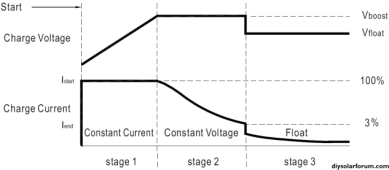Just a quick questions so I understand better.
If I have 3 growatts in paralell with 100a max charge current each.
4 x 16s 280k 48v batteries with centralised busbar (not daisy chained)
no coms between inverter and batteries.
Example Scenario
Its a sunny day and solar is strong and doing the full 100a from each inverter. if the batteries are slightly out of balance to each other and 3 batteries get full. Would the remaining battery then get the full 300a charge? and trigger protection from BMS? Or can the BMS restrict current that it accepts via the parameters?
If I have 3 growatts in paralell with 100a max charge current each.
4 x 16s 280k 48v batteries with centralised busbar (not daisy chained)
no coms between inverter and batteries.
Example Scenario
Its a sunny day and solar is strong and doing the full 100a from each inverter. if the batteries are slightly out of balance to each other and 3 batteries get full. Would the remaining battery then get the full 300a charge? and trigger protection from BMS? Or can the BMS restrict current that it accepts via the parameters?



